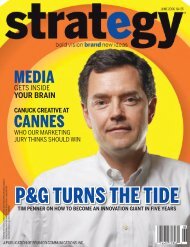download the PDF version - Strategy
download the PDF version - Strategy
download the PDF version - Strategy
You also want an ePaper? Increase the reach of your titles
YUMPU automatically turns print PDFs into web optimized ePapers that Google loves.
DIVERSIFYING<br />
a white man’s world<br />
BY MEGAN HAYNES<br />
How does a lack of diversity in <strong>the</strong> senior ranks impact<br />
strategy, creativity and <strong>the</strong> bottom line? “It’s a brain drain.”<br />
PANELISTS<br />
Aldo Cundari<br />
Chairman and CEO,<br />
Cundari<br />
Susan Lloyd<br />
Senior director, talent,<br />
Loblaw<br />
Alison Leung<br />
Marketing director, brand<br />
building and co-chair of<br />
WIN, Unilever<br />
Mat<strong>the</strong>w Logue<br />
VP strategy and partner,<br />
S&E Sponsorship Group<br />
Mary Maddever<br />
Editor in chief, strategy<br />
magazine (moderator)<br />
Nancy Vonk<br />
Founder, Swim<br />
A<br />
ccording to Statistics Canada, women make up 58.3%<br />
of <strong>the</strong> workforce, and as of 2006 (<strong>the</strong> latest statistics<br />
available), 61% of post-secondary graduating students.<br />
Visible minorities (excluding Aboriginals) make up 16.3% of <strong>the</strong><br />
workforce, and 16.2% of <strong>the</strong> total Canadian population. This number<br />
is expected to rise to 28% by 2031.<br />
Despite having proportional representation at <strong>the</strong> lower ranks,<br />
women and visible minorities make up only a fraction of senior<br />
management positions (29% and 5.2% respectively, according to a<br />
joint study by Deloitte and Carleton University, and ano<strong>the</strong>r by <strong>the</strong><br />
Conference Board of Canada). These numbers drop even fur<strong>the</strong>r at<br />
<strong>the</strong> CEO and board member levels (as low as zero in some sectors,<br />
such as manufacturing).<br />
While companies appear to have made great strides in creating a<br />
diverse workforce, at <strong>the</strong> top end, it’s still a white man’s world.<br />
That lack of decision-making diversity does not pay off. Studies<br />
vary, but companies with a diverse leadership often out-perform by<br />
as much as 47% in terms of revenue compared to similar companies<br />
with white, male-led boards and management. So why <strong>the</strong>n, despite<br />
<strong>the</strong> economic argument for diversity at <strong>the</strong> top, are companies<br />
struggling to fill senior positions with women and minority groups?<br />
Within <strong>the</strong> marketing world, creative agencies still largely look<br />
like <strong>the</strong>y did in <strong>the</strong> ’60s, dominated by men in president, CEO, CCO<br />
positions while <strong>the</strong> names topping <strong>the</strong> creative credits that cross<br />
strategy’s desk tend to be male-dominated. In fact, of <strong>the</strong> 300<br />
creative directors on last month’s Creative Report Card, only 44 are<br />
women – that’s 14%. That doesn’t even reflect <strong>the</strong> national average<br />
for women in middle manager positions.<br />
On <strong>the</strong> brand side, women and visible minorities appear to<br />
have better representation. Companies like Campbell and Loblaw<br />
have long had programs and networks designed for marginalized<br />
groups. However, even TD – hailed by <strong>the</strong> Corporate Knights<br />
Diversity Leadership Index as <strong>the</strong> most diverse Canadian company<br />
– maintains a board that is only 38% female. Better, but still not<br />
proportional. Fur<strong>the</strong>r, out of 492 Canadian Fortune 500 companies,<br />
only 27 have a female head or CEO.<br />
But efforts are pointing to a change. In 2009, Unilever’s global<br />
CEO, Paul Polman, announced his desire to increase women in<br />
leadership positions, stating <strong>the</strong> qualities <strong>the</strong>y bring to <strong>the</strong> table<br />
(such as au<strong>the</strong>nticity in leadership and long-term planning abilities)<br />
are a good business argument, and its Women Interactive Network<br />
is rolling out some ambitious plans to help get <strong>the</strong>re.<br />
<strong>Strategy</strong> set out to examine <strong>the</strong> issue of diversity (or lack <strong>the</strong>reof)<br />
and its impact on creative, strategy and <strong>the</strong> bottom line. So to kick<br />
things off, we invited folks from <strong>the</strong> industry to discuss <strong>the</strong> issue.<br />
Check back in April and May, when we look at <strong>the</strong> business case<br />
for diversity at senior levels and search for real-world solutions.<br />
20 www.strategyonline.ca














